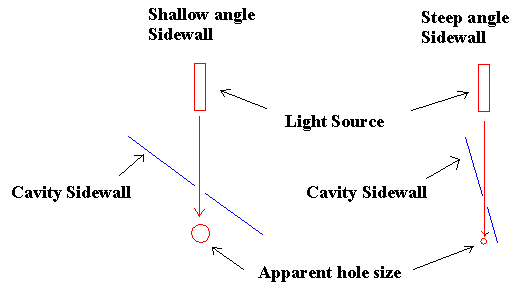
About Detecting Pinholes in Cavity Sidewalls
Detecting pinholes in flat materials is relatively straight forward. Cavity sidewall pinhole detection is more of a challenge.
Conventional pinhole detectors use a relatively narrow line (one dimensional array) of vertically directed light to penetrate pinholes. A corresponding relatively narrow line of detectors (one dimensional array) is positioned directly in line with the vertically directed light source.
As seen in the diagram above, a pinhole in the cavity sidewall when "viewed" by a conventional pinhole detector appear to have a smaller area then they actually do. The reduction in apparent area of the pinhole is dependent on the the vertical angle of the cavity wall. It can be seen that nearly vertical cavity walls reduce the apparent pinhole size to nearly zero.
Conventional System Solution
The solution some manufacturers use is to increase the system pinhole sensitivity until the smaller area sidewall pinholes can be detected. There are two problems with that approach:
1) There is an undesirable side effect to the customer - increased cost.
Increasing the sensitivity to levels sufficient to detect sidewall pinholes results in wasteful rejection of acceptable material. The rejection occurs because thin foils typically have some pinholes (see About Pinholes and Fractures). These pinholes may be of acceptable size for the application and rejection wastes time, material and money.
2) Sidewall Pinhole detection depends on formed cavity sidewall angle.
The steeper the formed cavity wall, the smaller pinhole area presented. Therefore it is not possible to set the device to detect a certain size pinhole, since its location in the sidewall strongly influences its apparent size. For nearly vertical walls or portions of walls, the pinhole virtually disappears (as seen by conventional systems). In such a case pinhole sensitivity would need to increase to unobtainable levels.
AlumiVision MDA ® Solution
The AlumiVision proprietary Multi Dimensional Array technology provides an innovative solution to the deficiencies of the conventional system sidewall pinhole detection.
The MDA technology generates a multi-directional inspection light beam. The multi-directional light impinges on the cavity sidewall pinhole at angles from vertical that allow the light to penetrate the full area of the pinhole.
The angled light emerging from the sidewall pinhole is detected by a multi dimensional receiver. The receiver design allows it to capture light angled to vertical as well as vertical directed light.
The result is superior sidewall pinhole detection without the negatives of conventional systems.

